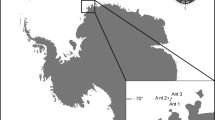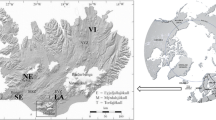Abstract
Thirteen asexually reproducing clones of Enteromorpha linza were found in samples collected from March to September 1982 in Long Island Sound, USA, based on variation at five enzyme loci. Significant differences in the relative frequency of each clone were observed among samples from 16 localities. There was a tendency for localities at the eastern end of the Sound to form a group genetically differentiated from localities at the western end, but in general there was no strong relationship between geographic distance and genetic distance. Areas separated by only a few hundred meters were genetically differentiated, despite the presence of a dispersing spore stage in this species. Samples from areas of low salinity were genetically similar but distinct from adjacent high salinity areas. One clone restricted to high salinity localities and one associated with low salinity localities were tested for growth under high and low salinity conditions in the laboratory. The clone from the high salinity habitat grew more slowly under low salinity conditions. However, there was no evidence for a detrimental effect of high salinity on the low salinity associated clone. Additional environmental factors, as well as biological factors such as limited recruitment and competitive interactions among clones, may also be important determinants of genetic differentiation among populations of E. linza. Temporal shifts in clone frequency were observed within some localities and may be due to seasonal-dependent regeneration from microscopic holdfasts for different clones or a seasonal recruitment of new clones from other areas. The pattern of differentiation among populations of E. linza in Long Island Sound appears to be maintained by factors operating on a microgeographic scale.
Similar content being viewed by others
Literature cited
Amsler, C. D. and R. B. Searles: Vertical distribution of seaweed spores in a water column offshore of North Carolina. J. Phycol. 16, 617–619 (1980)
Anderson, E. K. and W. J. North: In situ studies of spore production and dispersal in the giant kelp, Macrocystis. Proc. int. Seaweed Symp. 5, 73–86 (1966)
Archie, J., C. Simon and D. Wartenberg: Geographical patterns and population structure in periodical cicadas based on spatial analysis of allozyme frequencies. Evolution 39, 1261–1274 (1985)
Berger, E.: Gene-enzyme variation in three sympatric species of Littorina. Biol. Bull. mar. biol. Lab., Woods Hole 145, 83–90 (1973)
Black, R. and M. S. Johnson: Asexual viviparity and population genetics of Actinia tenebrosa. Mar. Biol. 53, 27–31 (1979)
Burton, R.: Protein polymorphisms and genetic differentiation of marine invertebrate populations. Mar. Biol. Lett. 4, 193–206 (1983)
Cheney, D. P.: Electrophoresis. In: Handbook of phycological methods: ecological methods for macroalgae, Vol. IV. pp 87–119. Ed. by M. Littler and D. Littler. Cambridge: Cambridge University Press 1986
Dayton, P. K.: Dispersion, dispersal and persistence of the annual intertidal alga Postelsia palmaeformis Ruprecht. Ecology 54, 433–438 (1973)
Dixon, P. S.: Perennation, vegetative propagation and algal life histories with special reference to Asparagopsis and other Rhodophyta. Bot. Gothoburg 3, 67–74 (1965)
Ellstrand, N. C. and D. A. Levin: Genotypic diversity in Oenothera laciniata (Onagraceae), a permanent translocation heterozygote. Evolution 36, 63–69 (1982)
Gooch, J. L.: Mechanisms of evolution and population genetics. In: Marine ecology, Vol. II, part 1, pp 349–409. Ed. by O. Kinne. London: J. Wiley 1975
Gower, J. C.: Some distance properties of latent roots and vector methods used in multivariate analysis. Biometrika 53, 325–338 (1966)
Hebert, P. D. N. and T. Crease: Clonal diversity in populations of Daphnia pulex reproducing by obligate parthenogenesis. Heredity 51, 353–369 (1983)
Hedrick, P. W.: A new approach to measuring genetic similarity. Evolution 25, 276–280 (1971)
Hedrick, P. W.: Genetic similarity and distance: comments and comparisons. Evolution 29, 362–366 (1975)
Innes, D. J.: Genetic differentiation among populations of marine algae. Helgoländer Meeresunters. 38, 401–417 (1984)
Innes, D. J. and C. Yarish: Genetic evidence for the occurrence of asexual reproduction in populations of Enteromorpha linza (L.) J. Ag. (Chlorophyta, Ulvales) from Long Island Sound. Phycologia 23, 311–320 (1984)
Jones, W. E. and M. S. Babb: The motile period of swarmers of Enteromorpha intestinalis (L.) Link. Br. Phycol. Bull. 3, 525–528 (1968)
Karlin, A. A., S. I. Guttman and S. L. Rathburn: Spatial autocorrelation analysis of heterozygosity and geographic distribution in populations of Desmognathes fuscus (Amphibia: Plethodontidae). Copeia 1984, 343–356 (1984)
Koehn, R. K., R. I. E. Newell and F. Immermann: Maintenance of an aminopeptidase allele frequency cline by natural selection. Proc. natl Acad. Sci. USA 77, 5385–5389 (1980)
Levin, D. A.: Genetic heterozygosity and protein polymorphism among local populations of Oenothera biennis. Genetics 79, 477–491 (1975)
Levin, D. A. and W. L. Crepet: Genetic variation in Lycopodium lucidulum: a phylogenetic relic. Evolution 27, 622–632 (1973)
Lubchenco, J.: Plant species diversity in a marine intertidal community: importance of herbivore food preference and algal competitive abilities. Am. Nat. 112, 23–39 (1978)
Malinowski, K. C.: Codium fragile: the ecology and population biology of a colonizing species, 135 pp. Ph. D. dissertation. Yale University, New Haven, CT 1974
Mathieson, A. C.: Vertical distribution and longevity of subtidal seaweeds in northern New England, U.S.A. Bot. mar. 30, 511–520 (1979)
McLachlan, J.: Growth media — marine. In: Handbook of phycological methods: culture methods and growth measurements, Vol. I, pp 25–51. Ed. by J. R. Stein. Cambridge: Cambridge University Press 1973
Miura, W., Y. Fujio and S. Suto: Genetic differentiation between the wild and cultured populations of Porphyra yezoensis. Tohoku J. agric. Res. 30, 1250–1256 (1979)
Paine, R. T.: Disaster, catastrophe, and local persistence of the sea palm Postelsia palmaeformis. Science, Wash. D.C. 205, 685–687 (1979)
Rohlf, F. J. and R. R. Sokal: Statistical tables, 2nd ed., 219 pp. San Francisco: W. H. Freeman and Co. 1981
Reed, R. H. and G. Russell: Adaptation to salinity stress in populations of Enteromorpha intestinalis (L.) Link. Estuar. cstl mar. Sci. 8, 251–258 (1979)
Schneider, C. W., M. M. Suyemoto and C. Yarish: An annotated checklist of Connecticut seaweeds. Conn. Geolog. nat. Hist. Survey Bull. 108, 1–20 (1979)
Shick, J. M. and A. N. Lamb: Asexual reproduction and genetic population structure in the colonizing anemone Haliplanella luciae. Biol. Bull. mar. biol. Lab., Woods Hole 153, 604–617 (1977)
Silva, M. W. R. N. de: An experimental approach to the taxonomy of the genus Enteromorpha (L.) Link, 226 pp. Ph.D. dissertation. Liverpool: University of Liverpool 1969
Sneath, P. H. A. and R. R. Sokal: Numerical taxonomy, 573 pp. San Francisco: W. H. Freeman and Co. 1973
Sokal, R. R. and N. L. Oden: Spatial autocorrelation in biology. 1. Methodology. Biol. J. Linn. Soc. 10, 199–228 (1978a)
Sokal, R. R. and N. L. Oden: Spatial autocorrelation in biology. 2. Some biological implications and four applications of evolutionary and ecological interest. Biol. J. Linn. Soc. 10, 229–249 (1978b)
Sokal, R. R. and F. J. Rohlf: Biometry, 2nd ed., 859 pp. San Francisco: W. H. Freeman and Co. 1981
Solbrig, O. T. and B. B. Simpson: Components of regulation of a population of dandelions in Michigan. J. Ecol. 62, 473–486 (1974)
Thorson, G.: Reproduction and larval ecology of marine bottom invertebrates. Biol. Rev. 25, 1–45 (1950)
Zechman, F. W. and A. C. Mathieson: The distribution of seaweed propagules in estuarine, coastal and offshore waters of New Hampshire, U.S.A. Bot. mar. 28, 283–294 (1985)
Author information
Authors and Affiliations
Additional information
Communicated by R. W. Doyle, Halifax
Rights and permissions
About this article
Cite this article
Innes, D.J. Genetic structure of asexually reproducing Enteromorpha linza (Ulvales: Chlorophyta) in Long Island Sound. Mar. Biol. 94, 459–467 (1987). https://doi.org/10.1007/BF00428253
Accepted:
Published:
Issue Date:
DOI: https://doi.org/10.1007/BF00428253




